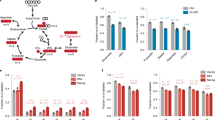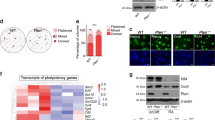Abstract
Embryonic stem (ES) cells can self-renew indefinitely without losing their differentiation ability to any cell types. Phosphoinositide-3 kinase (PI3K)/Akt signaling plays a pivotal role in various stem cell systems, including the formation of embryonic germ (EG) cells from primordial germ cells and self-renewal of neural stem cells. Here, we show that myristoylated, active form of Akt (myr-Akt) maintained the undifferentiated phenotypes in mouse ES cells without the addition of leukemia inhibitory factor (LIF). The effects of myr-Akt were reversible, because LIF dependence and pluripotent differentiation activity were restored by the deletion of myr-Akt. In addition, myr-Akt-Mer fusion protein, whose enzymatic activity is controlled by 4-hydroxy-tamoxifen, also maintained the pluripotency of not only mouse but also cynomolgus monkey ES cells. These results clearly demonstrate that Akt signaling sufficiently maintains pluripotency in mouse and primate ES cells, and support the notion that PI3K/Akt signaling axis regulates ‘stemness’ in a broad spectrum of stem cell systems.
This is a preview of subscription content, access via your institution
Access options
Subscribe to this journal
Receive 50 print issues and online access
$259.00 per year
only $5.18 per issue
Buy this article
- Purchase on Springer Link
- Instant access to full article PDF
Prices may be subject to local taxes which are calculated during checkout






Similar content being viewed by others
Accession codes
References
Ben-Shushan E, Thompson JR, Gudas LJ, Bergman Y . (1998). Mol Cell Biol 18: 1866–1878.
Boeuf H, Hauss C, Graeve FD, Baran N, Kedinger C . (1997). J Cell Biol 138: 1207–1217.
Brazil DP, Yang ZZ, Hemmings BA . (2004). Trends Biochem Sci 29: 233–242.
Burdon T, Smith A, Savatier P . (2002). Trends Cell Biol 12: 432–438.
Burdon T, Stracey C, Chambers I, Nichols J, Smith A . (1999). Dev Biol 210: 30–43.
Cantley LC . (2002). Science 296: 1655–1657.
Chambers I, Smith A . (2004). Oncogene 23: 7150–7160.
Chambers I, Colby D, Robertson M, Nichols J, Lee S, Tweedie S et al. (2003). Cell 113: 643–655.
Daheron L, Opitz SL, Zaehres H, Lensch WM, Andrews PW, Itskovitz-Eldor J et al. (2004). Stem Cells 22: 770–778.
Furuya M, Yasuchika K, Mizutani K, Yoshimura Y, Nakatsuji N, Suemori H . (2003). Genesis 37: 180–187.
Groszer M, Erickson R, Scripture-Adams DD, Lesche R, Trumpp A, Zack JA et al. (2001). Science 294: 2186–2189.
Hay N, Sonenberg N . (2004). Genes Dev 18: 1926–1945.
Humphrey RK, Beattie GM, Lopez AD, Bucay N, King CC, Firpo MT et al. (2004). Stem Cells 22: 522–530.
Jirmanova L, Afanassieff M, Gobert-Gosse S, Markossian S, Savatier P . (2002). Oncogene 21: 5515–5528.
Kielman MF, Rindapaa M, Gaspar C, van Poppel N, Breukel C, van Leeuwen S et al. (2002). Nat Genet 32: 594–605.
Kim SJ, Cheon SH, Yoo SJ, Kwon J, Park JH, Kim CG et al. (2005). FEBS Lett 579: 534–540.
Kimura T, Ito C, Watanabe S, Takahashi T, Ikawa M, Yomogida K et al. (2003a). Mol Cell Biol 23: 1304–1315.
Kimura T, Suzuki A, Fujita Y, Yomogida K, Lomeli H, Asada N et al. (2003b). Development 130: 1691–1700.
Kohn AD, Barthel A, Kovacina KS, Boge A, Wallach B, Summers SA et al. (1998). J Biol Chem 273: 11937–11943.
Masuyama N, Oishi K, Mori Y, Ueno T, Takahama Y, Gotoh Y . (2001). J Biol Chem 276: 32799–32805.
Matsuda T, Nakamura T, Nakao K, Arai T, Katsuki M, Heike T et al. (1999). EMBO J 18: 4261–4269.
Mitsui K, Tokuzawa Y, Itoh H, Segawa K, Murakami M, Takahashi K et al. (2003). Cell 113: 631–642.
Moon RT, Kohn AD, De Ferrari GV, Kaykas A . (2004). Nat Rev Genet 5: 691–701.
Nagata M, Takahashi M, Muramatsu S, Ueda Y, Hanazono Y, Takeuchi K et al. (2003). J Gene Med 5: 921–928.
Nakano T, Kodama H, Honjo T . (1996). Science 272: 722–724.
Niwa H, Burdon T, Chambers I, Smith A . (1998). Genes Dev 12: 2048–2060.
Niwa H, Yamamura K, Miyazaki J . (1991). Gene 108: 193–199.
Paling NR, Wheadon H, Bone HK, Welham MJ . (2004). J Biol Chem 279: 48063–48070.
Pesce M, Scholer HR . (2001). Stem Cells 19: 271–278.
Qi X, Li TG, Hao J, Hu J, Wang J, Simmons H et al. (2004). Proc Natl Acad Sci USA 101: 6027–6032.
Saitou M, Barton SC, Surani MA . (2002). Nature 418: 293–300.
Sato M, Kimura T, Kurokawa K, Fujita Y, Abe K, Masuhara M et al. (2002). Mech Dev 113: 91–94.
Sato N, Meijer L, Skaltsounis L, Greengard P, Brivanlou AH . (2004). Nat Med 10: 55–63.
Stiles B, Gilman V, Khanzenzon N, Lesche R, Li A, Qiao R et al. (2002). Mol Cell Biol 22: 3842–3851.
Stiles B, Groszer M, Wang S, Jiao J, Wu H . (2004). Dev Biol 273: 175–184.
Suemori H, Nakatsuji N . (2003). Methods Enzymol 365: 419–429.
Sumi T, Fujimoto Y, Nakatsuji N, Suemori H . (2004). Stem Cells 22: 861–872.
Sun H, Lesche R, Li DM, Liliental J, Zhang H, Gao J et al. (1999). Proc Natl Acad Sci USA 96: 6199–6204.
Takahashi K, Mitsui K, Yamanaka S . (2003). Nature 423: 541–545.
Xu RH, Peck RM, Li DS, Feng X, Ludwig T, Thomson JA . (2005). Nat Methods 2: 185–190.
Ying QL, Nichols J, Chambers I, Smith A . (2003a). Cell 115: 281–292.
Ying QL, Stavridis M, Griffiths D, Li M, Smith A . (2003b). Nat Biotechnol 21: 183–186.
Acknowledgements
We thank Dr H Suemori for generous help of culturing monkey ES cells, and Drs Y Gotoh, T Akiyama, H Niwa, S Takada and S Akira for providing materials and supporting microarray analysis. We also thank Dr E Morii for histological inspection and Ms M Ikeuchi, Y Fujita, T Asada, A Mizokami and A Kawai for assistance. SW is supported by scholarship from the Japanese Society for Promotion of Science. This work is supported in part by grants from the Ministry of Education, Science, Sports and Culture, Support Program for Technology Development on the Basis of Academic Findings (NEDO) and Uehara Memorial Foundation.
Author information
Authors and Affiliations
Corresponding authors
Additional information
Supplementary Information accompanies the paper on Oncogene website (http://www.nature.com/onc).
Supplementary information
Rights and permissions
About this article
Cite this article
Watanabe, S., Umehara, H., Murayama, K. et al. Activation of Akt signaling is sufficient to maintain pluripotency in mouse and primate embryonic stem cells. Oncogene 25, 2697–2707 (2006). https://doi.org/10.1038/sj.onc.1209307
Received:
Revised:
Accepted:
Published:
Issue Date:
DOI: https://doi.org/10.1038/sj.onc.1209307
Keywords
This article is cited by
-
AKT1 induces Nanog promoter in a SUMOylation-dependent manner in different pluripotent contexts
BMC Research Notes (2023)
-
Expression of Chrna9 is regulated by Tbx3 in undifferentiated pluripotent stem cells
Scientific Reports (2023)
-
Exploring the molecular mechanism underlying the psoriasis and T2D by using microarray data analysis
Scientific Reports (2023)
-
The role of the TGF-β/LIF signaling pathway mediated by SMADs during the cyst formation of Echinococcus in young children
BMC Molecular and Cell Biology (2022)
-
iPSCs derived from insulin resistant offspring of type 2 diabetic patients show increased oxidative stress and lactate secretion
Stem Cell Research & Therapy (2022)



